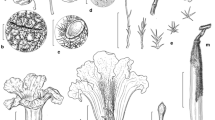Abstract
Morphological, cytological and field observations on 20 populations of theAgrostis mertensii-flaccida complex were reported. The plants were found to be diploid, tetraploid, hexaploid, septaploid or octoploid with a basic chromosome number of x=7. The diploids were most wide-spread and diverse in habitat and morphology. The tetraploids were discovered in 3 sites in Hokkaido. The hexaploids and octoploids occurred on various mountains in central and northern Honshu as well as in some of Hokkaido. A septaploid plant was found on Mts. Daisetsu. Pollen studies showed that diploid and tetraploid plants had smaller grains when compared with those of the hexaploids and the octoploids. The diploids, though variable in morphology and ecology, seemed to belong to a taxon which was more or less deviated morphologically from the diploid or tetraploid taxa growing outside Japan. The tetraploids were indistinguishable morphologically from the diploids. The hexaploids in Honshu, which were clearly different from the hexaploids in Hokkaido in morphology, possessed unique spikelet features. The majority of the octoploids were found to be distinct from the diploids and the tetraploids in the length ratio of anther/lemma. Some morphological “marker” features which distinguished between the diploids and the octoploids were observed for all of their sympatric populations, though such “marker” traits varied according to the localities. The taxonomic and evolutionary relationships between these Japanese entities and the taxa growing outside Japan were discussed. In conclusion, setting aside some plants which require further investigations, the Japanese plants concerned were arranged into 3 species:Agrostis flaccida Hack., including 2X and 4X together with 3X previously reported;A. tateyamensis Tateoka, sp. nov., implying 6X in Honshu;A. mertensii Trin. including 8X. A description ofA. tateyamensis was given.
Similar content being viewed by others
References
Björkman, S.O. 1951. Chromosome studies inAgrostis (A preliminary report). Hereditas37: 465–468.
— 1960. Studies inAgrostis and related genera. Symb. Bot. Upsal.17(1): 1–112.
Bolhovskih, Z.V., V.G. Grif, O.I. Zahar'eva, andT.S. Matveeva. 1969. Chromosome Numbers of Flowering Plants. Nauka, Leningrad.
Chen, C.-C. andC.-C. Hsu. 1962. Cytological studies on Taiwan grasses (2). Chromosome numbers of some miscellaneous tribes. J. Jap. Bot.37: 300–313.
Crawford, D.J. 1974. Variation in the seed proteins ofChenopodium incanum. Bull. Torr. Bot. Club101: 72–77.
Ehrlich, P.R. andP.H. Raven. 1969. Differentiation of populations. Science165: 1228–1232.
Hackel, E. 1899. Enumeratio Graminum Japoniae. Bull. Herb. Boiss. ser. 1.7: 637–654.
Hultén, E. 1968. Flora of Alaska and Neighboring Territories. Stanford Univ. Press, Stanford.
Jones, K. 1956a. Species differentiation inagrostis I. Cytological relationships inAgrostis canina L. Jour. Genet.54: 370–376.
— 1956b. Species differentiation inAgrostis II. The significance of chromosome pairing in the tetraploid hybrids ofAgrostis canina subsp.montana Hartm.,A. tenuis Sibth. andA. stolonifera L. Jour. Genet.54: 377–399.
Koyama, T. 1964. Gramineae.In: Kitamura, S. et al Coloured Illustrations of Herbaceous Plants of Japan, vol. 3: 301–388, Hoikusha, Osaka (in Japanese).
Mayr, E. 1970. Populations, Species and Evolution. Harvard Univ. Press, Cambridge.
Meusel, H., E. Jäger andE. Weinert. 1965. Vergleichende Chorologie der Zentraleuropäischen Flora. Fischer, Jena.
Nygren, A. 1962. Artificial and natural hybridization in EuropeanCalamagrostis. Symb. Bot. Upsal.17(3): 1–105.
Ohwi, J. 1933. Symbolae ad Floram Asiae Orientalis, 9. Acta. Phytotax. Geobot.2: 149–170.
— 1941. The tribe Agrosteae of Japan, excluding the genusCalamagrostis. Bot. Mag. Tokyo55: 350–362.
— 1965. Flora of Japan (2nd ed.). Shibundo, Tokyo (in Japanese).
Probatova, N.S. 1973. Poacearum species novae et rariores ex Oriente Extremo. Novit. Syst. Pl. Vasc.10: 68–79.
— 1974a. Gramineae.In: Vorobiev, D.P.et al. Key for the Vascular Plants of Sakhalin and Kurile Islands. Acad. Science, USSR., Leningrad.
— 1974b. Notae de Gramineis florae Orientis Extremi. Novit. Syst. Pl. Vasc.11: 57–69.
Scholz, H. 1969. Novitates systematicae specieiAgrostis coarctata Ehrh ex Hoffm. Willdenowia5: 479–487.
Snaydon, R.W. 1973. Ecological factors, genetic variation and speciation in palnts.In: Heywood, V.H. ed., Taxonomy and Ecology, p. 1–29. Academic Press, London.
Sokolovskaya, A.P. 1938. A caryogeographical study of the genusAgrostis. Cytologia8: 452–467.
-Sokolovskaya, A.P. and N.S. Probatova. Karyosystematic investigation of the Far Eastern species ofAgrostis L. Bot. Jour.59: 1278–1287.
Stebbins, G.L. 1971. Chromosomal Evolution in Higher Plants. Edward Arnold Ltd., London.
Tateoka, T. 1955. Karyotaxonomy in Poaceae. III. Further studies of somatic chromosomes. Cytologia20: 296–306.
Tateoka, T. 1967. Gramineae.In: IOPB Chromosome Number Reports. Taxon16: 561–564.
— 1969. On the morphological differences betweenAgrostis borealis andA. flaccida (Gramineae). Bull. Natn. Sci. Mus. Tokyo12: 637–642.
— 1970. Cytotaxonomic studies of theAgrostis borealis complex (Gramineae). I. Populations in Mt. Chôkai, Mt. Gojizô and Mt. Karakuni. Bull. Natn. Sci. Mus. Tokyo13: 263–273.
— 1971. Cytotaxonomic studies of theAgrostis borealis complex (Gramineae). II. Properties of the hexaploids. Bull. Natn. Sci. Mus. Tokyo14: 247–256.
— 1972. Cytotaxonomic studies of theAgrostis borealis complex (Gramineae). III. The occurrence of spontaneous triploids. Bull. Natn Sci. Mus. Tokyo15: 455–460.
Taylor, R.L. andG.A. Mulligan. 1968. Flora of the Queen Charlotte Islands. Part 2. Cytological Aspects of the Vascular Plants Queen's Printer, Ottawa.
Tzvelev, N. 1964.Agrostis.In: Tolmatchev, A. ed., Flora Arctica URSS, Fas. II Gramineae. Nauka, Leningrad.
— 1971. Notae de Gramineis florae URSS, 6. Novit Syst. Pl. Vasc.8: 57–83.
Vovk, A.G. 1970. Chromosome numbers of the UkrainianAgrostis species and forms. Ukrajins'kij Bot. Žurnal27: 739–742.
Widén, K.-G. 1971. The genusAgrostis L. in eastern Fennoscandia. Taxonomy and distribution. Flora Fennica5: 1–209.
Zukova, P.G. 1967. Chromosome numbers in some species of plants of the north-eastern part of the USSR II. Bot. Žurnal52: 983–987.
Author information
Authors and Affiliations
Rights and permissions
About this article
Cite this article
Tateoka, T. A contribution to the taxonomy of theAgrostis mertensii-flaccida complex (Poaceae) in Japan. Bot Mag Tokyo 88, 65–87 (1975). https://doi.org/10.1007/BF02491243
Received:
Issue Date:
DOI: https://doi.org/10.1007/BF02491243




